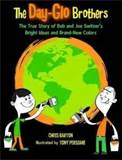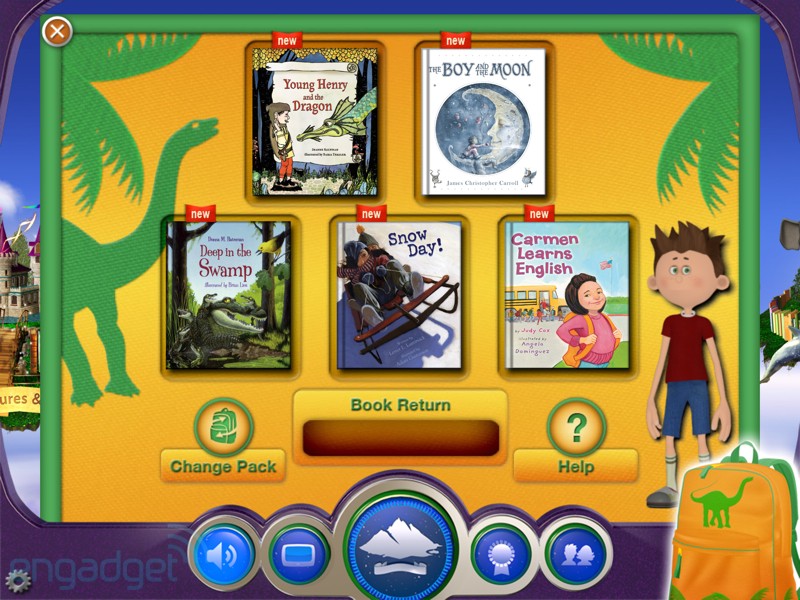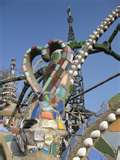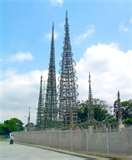My favorite Earth Day book: Wangari’s Trees of Peace
 Sometimes I fear that I can’t make a real difference in helping the planet, but Wangari’s Trees of Peace: a true story from Africa by Jeanette Winter shows how powerful one person’s actions can be. Wangari Maathai was devastated to see how barren Kenya was after thousands of trees were cleared. Soil was eroding and crops wouldn’t grow. The birds were gone. Women walked for miles to gather firewood. “I can begin to replace some of the lost trees here in my own backyard – one tree at a time.”
Sometimes I fear that I can’t make a real difference in helping the planet, but Wangari’s Trees of Peace: a true story from Africa by Jeanette Winter shows how powerful one person’s actions can be. Wangari Maathai was devastated to see how barren Kenya was after thousands of trees were cleared. Soil was eroding and crops wouldn’t grow. The birds were gone. Women walked for miles to gather firewood. “I can begin to replace some of the lost trees here in my own backyard – one tree at a time.”
Wangari started with nine seedlings, which grew into a nursery. Wangari gave new seedlings to village women for them to plant, and gave them money to keep those trees thriving. When Wangari tried to stop the clearing of old trees, she was beaten and arrested. But her message of caring for the Earth was taking root just like her trees were, and because of her, Kenyan women planted over 30 million trees, saving their land and making life there better.
For Earth Day/Arbor Day/natural resources units/biography units/non-fiction read-alouds that you can finish in one sitting, this is my new go-to book. Just by reading it and discussing it with students, you’re hitting the Common Core Standard of Range of Reading (a biography that teaches science and social studies? Non-fiction score!) Wangari’s Trees of Peace is also excellent for an ecological cause-and-effect lesson, one of the big pieces of Key Ideas and Details. Using the book for reference, students can write and draw the effects of deforestation (crops wouldn’t grow, birds were gone, lack of firewood) and the effects of planting all those trees (women don’t have to walk so far to gather firewood, more birds, crops growing in the soil.) Winter’s picture book doesn’t delve deeply into the science of why a lack of trees leads to soil erosion, so you can share Planting the Trees of Kenya: the story of Wangari Maathai by Claire A. Nivola if you need to build that knowledge with your students. Use both books as resources for student writing and drawing, and now you’re Integrating Knowledge and Ideas!
If in the past you’ve received more apple-themed coffee mugs than you need as end-of-the-year teacher gifts, you can suggest that in lieu of a present for you, students can give a gift to us all by planting a tree. If you can spring for a seedling or if your parent-teacher organization will chip in, plant a tree with your students and let them help take responsibility for watering it (seeds are cool, but watering a visible seedling is way more exciting than watering a patch of dirt.) Wangari’s Trees of Peace may plant in your students a dedication to care for our planet.
Read More
Drummer Boy of John John
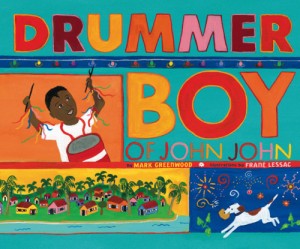 Maybe it’s the vibrant art or maybe it’s the tropical setting of Trinidad, but on this snowy March day, I am in love with Drummer Boy of John John by Mark Greenwood with illustrations by Frane Lessac. Knowing that it’s a biography (so it hits the Common Core standard of Range of Reading) that incorporates music and art makes me love it even more.
Maybe it’s the vibrant art or maybe it’s the tropical setting of Trinidad, but on this snowy March day, I am in love with Drummer Boy of John John by Mark Greenwood with illustrations by Frane Lessac. Knowing that it’s a biography (so it hits the Common Core standard of Range of Reading) that incorporates music and art makes me love it even more.
It’s almost time for Carnival and everyone in Winston’s town is getting ready to celebrate with calypso music. Winston wishes he were in a band, because the best band in the parade will get free rotis from the Roti King. (Is your Craft and Structure Common Core Standard alarm ringing? Lots of interesting word choices in this book!) But Winston has no gourds full of seeds that go “shoush-shap/ shukka-shac” and no bamboo to pound on the ground with a “click clack/ rappa-tap” (Check Print Concepts off on your Common Core score card). When Winston throws his mango pit into the junkyard, he hears a “pong ping pang” as the pit hits old metal. Winston makes his own instrument from the dented metal containers – the first steel drum. Winston’s friends hear this music and form a junkyard band. They paint pots, pans, tins, and cans rainbow colors and experiment with the dents and bumps in the metal to make different pitches. Winston’s band is crowned the best band in the Carnival parade, so they all feast on rotis and mango lemonade.
This book has so many tie-ins for art, music, and social studies. (I wish I’d found it a month ago, so I could’ve used it for Carnival/Mardi Gras, but it’s a fun lesson any time of year.) Students can use recycled cans, jars, bottles and containers to make their own instruments. Paint them in the tropical rainbow colors Lessac used in her art. Play a clip of steel drum music for students (you can get cd’s from your local library or use this Youtube clip: Steel Drums in Trinidad and Tobago. Bring in mangos for students to taste after they try dancing under the limbo pole like the Roti King does. Use your recycled instruments to play a “listen and repeat” rhythm game to build listening skills. Winston Simon began with junk from the junkyard and ended up touring London and Paris with the Trinidad All Stars Percussion Orchestra. Who knows where tin cans and this inspirational book might take your students?
For more information about the author, visit: markgreenwood.com.au.
For more information about the illustrator, visit: franelessac.com
Read More
The Day-Glo Brothers on a free app – what a bright idea!
I’m a librarian partly because I couldn’t afford my book habit if I had to buy every book I read. So when I’m looking for e-books, I usually look for free ones (some call me cheap, I prefer “fantastically frugal”). But I don’t want crummy books – I want the good stuff! Leave it to Reading Rainbow to hook me up with quality children’s books for free (and a huge variety of even more titles if I want to pay for a subscription).
I downloaded the free Reading Rainbow app to my iPad and was greeted by Levar Burton ( a man who has lured more children to reading than the Pied Piper lured rats, but you don’t have to take *my* word for it.) I was thrilled to find one of my favorite biographies, with complete text and art, a bit of fun animation, and even a game to play.
The Day-Glo Brothers: the true story of Bob and Joe Switzer’s bright ideas and brand-new colors is written by Chris Barton and illustrated by Tony Persiani. Bob and Joe Switzer were in their father’s drugstore when they discovered that certain chemicals glow under ultraviolet light. With lots of experimenting and some accidental luck, the brothers invented colors that would glow even in sunlight, those neon colors called Day-Glo. It’s a “brilliant” story about perseverance, for, as Joe used to say, “If just one experiment out of a thousand succeeds, then you’re ahead of the game.”
So now you can share this enlightening biography (CCSS Range of Reading – check!) with your students for free in paper-book form from the library, or you can share it on iPads with the free Reading Rainbow app. Charlesbridge has a free activity guide to go with the book, along with an author interview and an animation on how fluorescence works. How fun would it be to put a blacklight in a lamp in your classroom and get fluorescent markers for an art project. Students can try making one of the props Joe used in his magic shows, or you can have students demonstrate with Day-Glo colors why we see the phases of the moon. A great biography on a free app – what a bright idea!
Read More
Dream Something Big
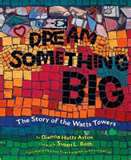 Dream Something Big: the Story of the Watts Towers, written by Dianna Hutts Aston with collages by Susan L. Roth, is a visually stunning biography of an artist you may never have heard of before. Simon Rodia was simply Uncle Sam to his neighbors in Los Angeles. Over 34 years, Sam built towers from broken bits of tile, glass, and cement that soar up to 99 feet high. His incredible recycled-art structures are now a National Landmark.
Dream Something Big: the Story of the Watts Towers, written by Dianna Hutts Aston with collages by Susan L. Roth, is a visually stunning biography of an artist you may never have heard of before. Simon Rodia was simply Uncle Sam to his neighbors in Los Angeles. Over 34 years, Sam built towers from broken bits of tile, glass, and cement that soar up to 99 feet high. His incredible recycled-art structures are now a National Landmark.
At the end of this gorgeously illustrated book you’ll find jaw-dropping photos of the Watts Towers. I’m including a close-up of the towers here so you can see the details as well as a photo that shows just how huge these works of art are. Share Dream Something Big with your students and do a fun math activity. Just how tall is a 99-foot tower? Get out the rulers and chalk and head to the playground or parking lot. Divide 99 by the number of students you have and let them take turns measuring and marking out each foot in 99 feet. Stand at one end of the length when you are done and imagine that distance soaring into the sky. Decorate the 99 feet with chalk “collages”, coloring bright shapes to resemble Sam’s art. Build your own towers with scrap materials, pipe cleaners, clay, etc. and encourage your students to “dream something big” like Sam did. For more inspiration, visit Dianna Hutts Aston’s website: diannahaston.com or Susan Roth’s website: susanlroth.com
Read More



